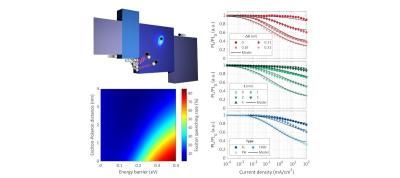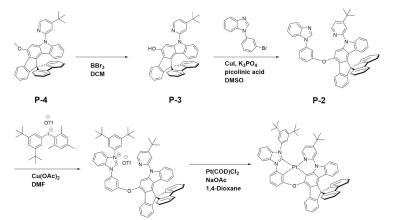OLED Lifetime: introduction and market status
OLED displays use organic materials that emit light when electricity is applied. OLEDs enable emissive, bright, thin, flexible and efficient displays. OLEDs are set to replace LCDs in all display applications - from small displays to large TV sets.

UDC OLED material performance, 2012
One of the main problems of OLED displays is the limited lifetime of the OLED materials. In past years we have seen great advances in this area, and today OLED materials are quite long lasting - with material lifetime reaching million hours or more.
Blue OLED lifetime
A blue OLED emitter is the most unstable emitter, and blue OLEDs (required to create a full-color display) suffer from short lifetimes. This is especially true for the efficient phosphorescent blue emitter - and today there's still no commercial efficient blue emitter.
The OLED industry is seeking several routes to develop an efficient blue. PHOLED pioneer Universal Display is developing a blue PHOLED, but has yet to find a commercial-ready material. Other promising route is TADF emitter technology.
BNTPA molecule shows promise for long-lasting high-efficiency deep red MR-TADF emitters
Researchers from the University of Science and Technology of China (USTC and the Beijing Information Science and Technology University (BISTU), have developed a new strategy for the design of deep red MR-TADF OLED emitters, that offers high efficiency, good color emission and long lifetimes.
The researchers report they have developed a new deep red (0.657,0343 CIE) OLED emitter material that achieves high efficiency, over 43% EQE, which they say is the most efficient MR-TADF red emitter.
Applied Materials launches a maskless OLED production technology, to support 8-Gen high efficiency OLED deposition and encapsulation
Applied Materials announced a technology, branded as MAX OLED that enables OLED display production on large glass substrates, aiming to provide a cost-effective solution to produce TV and TV displays. Applied developed and patented a new OLED pixel architecture and a "dramatically different manufacturing approach" that the company says enables brighter, clearer, more energy-efficient and longer-lasting.
Applied's new MAX OLED systems can scale from 6-Gen substrates to 8-Gen substrates, supporting the new wave of IT OLED production lines. Applied says that its new solution has strong customer interest - and already achieved repeat orders from several leading display makers (see below). Specifically, Applied announced that it will supply an R&D system to Samsung Display that will test the new production technology for its AMOLED and QD-OLED production technologies.
Researchers from SNU and Samsung identify a critical mechanism in OLED performance degradation, and use the knowledge to dramatically improve OLED efficiency and lifetime
Researchers from Seoul National University (SNU), in collaboration from colleagues from Samsung's SAIT institute, have identified a critical mechanism behind the performance degradation of OLED devices, the interfacial exciton-polaron quenching mechanism.
The researches have theoretically proposed a mechanism where excitons in the light-emitting layer are quenched by the accumulated charges at the interface. They followed with with experiments that have independently observed this phenomenon, identifying three key factors: interfacial barrier, exciton-polaron distance, and exciton lifetime.
Inuru's flexible OLED holo tags - hands on review
A few months ago Inuru started shipping its range of OLED-powered stickers, or "holo tags" as the company refers to them. These are battery-powered flexible stickers that can be used for laptops or any other use.
The company was kind enough to send us three stickers, from their latest Cyberpunk range. These stickers cost around 20 Euros, and there are many alternative designs. The idea is that the flexible stickers include a small OLED, a battery and a button that lights up the OLED for a few seconds. The whole device is said to be waterproof, but I did not test it.
Inuru says that the lifetime of the OLED is about 5,000 hours. As the battery is limited, though, they say that each sticker is limited at around 2,500 clicks. Some of them use a red OLED, and some a blue one.
LG to launch screensaver ads on OLED TVs, do owners need to worry about lifetime and burn-in?
LG Electronics is going to add screensaver ads to its TVs, including its high-end OLED TV range. It seemed the company has already started testing this new feature, which shows full-screen ads, and the company will offer a way to turn the ads off, as it markets the new ad system a "feature".
LG Ad Solutions company announced the new "Native Screensaver Ads" feature, that "capitalizes on idle screen time, turning what may be perceived as a period of downtime into a valuable engagement opportunity".
Lordin reports on a highly efficient and stable ultra-pure blue phosphorescent OLED emitter
Researchers from LORDIN, in collaboratioon with researchers from Korea's Dankook University, Gachon University and Hongik University, have reported on a highly efficient and stable ultra-pure blue phosphorescent OLED emitter, based on Lordin's Tetradentate Pt(II) material Complex with a vibration suppression effect.
The researchers say that the new emitter offers a lifetime of 451 hours (LT50 at 1,000 cd/m2), and an EQE of 25.1%. The emission spectrum is extremely narrow - full width at half a maximum of 22 nm. The researchers further developed a tandem OLED device based on this new emitter, which achieves an EQE of 50.3% and a lifetime of 589 hours (LT 70).
Researchers improve the lifetime of OLED devices 4X by adopting a deuterated host material
Researchers from Tsinghua University in Shenzhen, China, have managed to dramatically increase the stability of OLED devices by the adoption of deuterated host material.
The researchers, led by Prof. Man-Chung Tang, have designed and synthesized deuterated anthracene-based hydrocarbon PNA as the new host material. The researchers have observed that the faraday loss decreases with the increase of the deuteration degree.
LG Display to soon commercialize a tandem architecture blue phosphorescence OLED display
A report from Korea says that LG Display has successfully developed an OLED panel that is based on a blue phosphorescence emitter. The blue PHOLED, provided by Universal Display, offers 100% IQE, up from 25% used by current fluorescence emitters. This will result in around 20-30% power saving for the display itself (depending on the images shown).
UDC has been developing blue emitters for many years, and recently the company said that the development will take a few more months and won't be ready in 2024. The main challenge is increasing the lifetime of the materials. However LG Display has adopted a tandem design to enable a commercially ready display, perhaps even sooner than UDC planned.
Next-generation OLED technologies that will enable brighter and more efficient displays
OLED displays have been gaining popularity rapidly, and are already the dominant smartphone display technology. OLEDs are also the display technology of choice in the smartwatch market, making inroads into the TV, monitor, laptop and tablet markets. The future of the OLED industry looks bright.
In recent years, the focus of the industry, beyond increasing capacity and reducing production costs, has been improving the performance of OLEDs in the areas of display brightness, efficiency, and lifetime. Brightness is required in many applications - from TVs (for HDR and to view in ambient lighting) through smartphones (outdoor viewing) to automotive, and efficiency is a plus in any scenario (but mostly in mobile displays). Display lifetime is already good enough for many applications, but in some cases (like automotive, and IT displays) it is critical. These three properties usually go together - if you can make more efficient OLED displays, you can drive them at a lower current to achieve the same brightness, and so lifetime increases, or you can achieve higher brightness, etc.
ETNews: Samsung Display to supply its latest M14 AMOLED panels to Apple and Google
ETNews reports that Samsung Display has developed a new OLED stack, the M14 stack, that it will sell to both Apple and Google to be used in their latest smartphones. The new stack improve the efficiency, lifetime and brightness of the display compared to SDC's previous generation stack.
According to ETNews, the new M14 stack will be used int he upcoming iPhone 16 Pro and Pro Max. Apple's regular iPhone 16 models will use the previous AMOLED stack, Samsung's M12. Google will also adopt the M14 stack in its Pixel 9 (all 3 model types) and the upcoming Pixel Fold 2.
Pagination
- Page 1
- Next page










